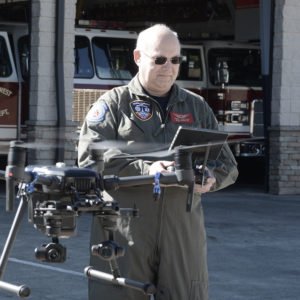 In this week’s column, Public Safety Drone Crash Highlights – spectacular fails, and how you can avoid them.
In this week’s column, Public Safety Drone Crash Highlights – spectacular fails, and how you can avoid them.
The following is one of a biweekly series on public safety drone issues by Steve Rhode, Chief Pilot with the Wake Forest Fire Department and the North Carolina Public Safety Drone Academy, and founder of Public Safety Flight, a website dedicated to information about the use of unmanned aircraft systems (UAS), UAVs, aircraft, and drones in public safety. (Not to be contrued as legal advice: please see details at the FAA government site. Opinions are the author’s.)
Public Safety Drone Crash Highlights: Why Those Pesky Rules Exist.
On a windy afternoon a few weeks ago, a call came in about some people lost on a raft on a small lake.
Public safety staff jumped into action and launched their UAS to get out over the lake to find the missing people on the raft.
Not to spoil the surprise but the COA agency making the flight wound up losing the aircraft and now has to file a report with the FAA and NTSB and defend their actions.
The agency has graciously permitted me to share what happened so we can all learn from the crash.
From my point of view, the very first decision a pilot should make is if the flight is necessary at all. I’d much rather talk myself into flying than out of flying. It is the more prudent risk analysis position to take.
Three indisputable facts should always be kept in mind when you are deciding to fly. First, gravity always wins. Second, no small public safety drone made today has been determined to be safe to fly. You fly at your own risk. Three, is the drone the best tool for the task at hand?
Upon arriving at the lake, the public safety pilot selected a Landing Zone (LZ) that put the wind to his back. His outbound flight was very fast at up to 45 MH, but the return flight into the wind can chew up a lot of battery power and, as others have learned, can drop you in the water when the battery expires.
The pilot flew the drone more than 6,600 feet out while trying to do a good thing. Unfortunately, he was about a mile beyond his ability to maintain VLOS. No Visual Observer (VO) was used to conduct a legal BVLOS flight.
The missing people on the raft had a functioning cell phone with them, they were not at risk of sinking, and they were communicating with dispatch. They wound up on land. So there was no risk to life.
Even though the data file shows the pilot switched to P (Positioning) mode, it also shows the aircraft remained in S (Sport) mode. A data anomaly that, to me, indicates some software glitches.
Also curious was the discrepancy between the barometric altitude and the collision avoidance sonar altitude. As the barometric altitude was descending, the sonar altitude remains fixed at 38.7 feet until about half a second before the crash—another telemetry anomaly.
On the return flight, the aircraft made it back to within 2,300 feet from the LZ. However, that distance is still far outside the ability to maintain VLOS compliant flight. Remember, even a BVLOS flight requires VLOS compliance by a VO. The Beyond Visual Line of Sight refers to the pilot, not the flight. A fact far too many pilots do not grasp.
As the aircraft was returning, it began to descend without the pilot making any downward input. Within about eight seconds, the drone crashed into the lake. It rapidly fell out of the sky in the last few seconds at a speed of 32 MPH.
Here is what we can learn from this recent crash.
- You can’t trust the telemetry of the UAS alone. There is no public safety drone manufactured that allows you to fly using only telemetry safely. The PIC or VO must have eyes on the drone to determine the altitude and other critical factors of flight. If the PIC had eyes on this flight, he could have taken evasive action since he had eight seconds before the impact after it started to descend from 155 feet AGL.
- Winds need to be considered before flying. There was an unfavorable tailwind to return into. The stiff wind would impact the drone on the critical return trip. In this case, the drone crashed with 52 percent of its battery power. But I know of others that lost battery power and crashed while flying back into the wind. If you can easily select an LZ that puts the wind in your face at take-off, that is the better choice.
- Since the middle of the lake was a few hundred feet from either shore, binoculars would have been the better tool to use than the drone. It would have accomplished the task and mitigated unnecessary flight risk.
- The pilot flew far beyond the regulations for BVLOS or VLOS, and an official accident investigation is going to notice that. The analysis can always result in civil fines and penalties for both the pilot and COA agency from a needless flight.
- We are lucky the drone went down in the lake and not into the neighborhoods surrounding the lake. The drone was at 155 feet AGL before the crash, and the impact could have been fatal if it struck someone.
The more significant issue here is not that the pilot made some unfortunate decisions but that we can all learn something from the department budget lost in the lake.
 Steve Rhode is an FAA-certificated airplane commercial and instrument certificated pilot, an experienced Part 107 UAS commercial pilot, and Chief Pilot with the Wake Forest Fire Department and the North Carolina Public Safety Drone Academy. He provides expert advice to drone pilots through Homeland Security Information Network and as an FAA Safety Team drone expert. Steve is the founder Public Safety Flight, a website dedicated to news, honest information, tips, and stories about the use of unmanned aircraft systems (UAS), UAVs, aircraft, and drones in the fire service and other public safety niches. Sign up for thePublic Safety Flight newsletter to join Steve’s private email list, or contact Steve here. In the airplane, his FAA callsign is Fire Demon 1: and Firebird 1 with the drone.
Steve Rhode is an FAA-certificated airplane commercial and instrument certificated pilot, an experienced Part 107 UAS commercial pilot, and Chief Pilot with the Wake Forest Fire Department and the North Carolina Public Safety Drone Academy. He provides expert advice to drone pilots through Homeland Security Information Network and as an FAA Safety Team drone expert. Steve is the founder Public Safety Flight, a website dedicated to news, honest information, tips, and stories about the use of unmanned aircraft systems (UAS), UAVs, aircraft, and drones in the fire service and other public safety niches. Sign up for thePublic Safety Flight newsletter to join Steve’s private email list, or contact Steve here. In the airplane, his FAA callsign is Fire Demon 1: and Firebird 1 with the drone.

Miriam McNabb is the Editor-in-Chief of DRONELIFE and CEO of JobForDrones, a professional drone services marketplace, and a fascinated observer of the emerging drone industry and the regulatory environment for drones. Miriam has penned over 3,000 articles focused on the commercial drone space and is an international speaker and recognized figure in the industry. Miriam has a degree from the University of Chicago and over 20 years of experience in high tech sales and marketing for new technologies.
For drone industry consulting or writing, Email Miriam.
TWITTER:@spaldingbarker
Subscribe to DroneLife here.







[…] Read more from Steve Rhode: Part 1, VLOS flight at night; public safety crash highlights. […]